Application of Some Modern Analytical Techniques for Characterization of Non-Metallic Inclusions in a Fe-10mass%Ni Alloy Deoxidized by Ti/Zr and Ti/Mg
Abstract
1. Introduction
- -
- Automated methods of quantitative metallographic studies are used for determination of the number, size and type of non-metallic inclusions;
- -
- Methods based on local X-ray spectral analysis using microprobes or methods using electrolytic extraction followed by subsequent chemical analysis, petrography, and X-ray diffraction are used for the evaluation of the morphology and composition of inclusions;
- -
- Gas analysis methods are used to determine the amount of gas-forming elements in steels, including C, O, H, N and S.
2. Materials and Methods
2.1. Sample Preparation
2.2. Investigation of Non-Metallic Inclusions and Clusters by Different Methods
2.2.1. Electrolytic Extraction Method (EE + SEM)
2.2.2. Fractional Gas Analysis (FGA)
3. Results and Discussion
3.1. Evaluation of NMIs in Ti and Ti/Zr Experiments
3.2. Evaluation of NMIs in Ti/Mg Experiments
4. Conclusions
- Depending on morphology, size and composition, the following three main types of oxide inclusions and clusters were observed after electrolytic extraction of metal samples in all Ti/Zr and Ti/Mg deoxidation experiments: (i) small spherical inclusions (0.5–5 µm) having large contents of FeO and TiOx and low contents of ZrO2 (Type I) or MgO (Type IV); (ii) inclusions consisting of a FeO-TiOx core and a rough outer solid layer or precipitated solid oxide phase containing larger amounts of ZrO2 (Type II) or MgO (Type V); (iii) large size clusters (up to 26 and 13 μm in Ti/Zr and Ti/Mg experiments, respectively) containing higher concentrations of ZrO2 (Type III) or MgO (Type VI).
- The peaks of oxygen reduced from different oxides obtained by the FGA measurements correspond well to the main types of inclusions and clusters observed in the investigated metal samples observed in 3D by using the EE + SEM method. The frequencies of the main types of oxide inclusions and clusters in the Ti, Ti/Zr and Ti/Mg deoxidation experiments obtained by using the EE + SEM and FGA methods showed similar tendencies with an increased holding time of the melt after an addition of Zr or Mg.
- After an addition of Zr in the melt deoxidized by Ti, the total O content, reduced from all oxide inclusions (ONMI) during the FGA measurement, increased slightly in the Ti/Zr-1 sample. Thereafter, it decreased linearly by ~40% in the Ti/Zr-5 sample due to floatation of oxide inclusions from the melt during the holding period. At that time, the amount of NMIs with higher concentrations of ZrO2 (Group 2) increased by approximately 2 times, despite that the number of almost pure ZrO2 inclusions and clusters (Group 3) decreased during the holding period.
- After an addition of Mg in the melt deoxidized by Ti, the ONMI content decreased drastically by 49% in the Ti/Mg-1 sample and by 63% in the Ti/Mg-5 sample compared to that in the Ti-1 deoxidation experiment. This is due to a fast removal of oxide inclusions due to the floatation caused by rising bubbles containing vaporized Mg. However, the amount of NMIs at larger MgO contents (Groups 5 and 6) decreased significantly from 65% in the Ti/Mg-3 sample up to 24% in the Ti/Mg-5 sample. This is due to a fast decrease of the Mg content in the melt.
- A combination of the given modern analytical techniques can be successfully applied for complete quantitative and qualitative evaluations of oxide non-metallic inclusions and clusters in a wide range of steels and alloys. More specifically, the EE method was used to enable 3D investigations of real characteristics of NMIs (such as morphology, size distribution, number and composition) by using a scanning electron microscopy (SEM). The FGA method was applied to enable a fast (about 10–15 min per analysis including sample preparation) and more representative (~1.0–1.5 g of metal specimen per an analysis) quantitative determination of the total amount and compositions of main oxide phases in typical inclusions and clusters. It was found that these two analytical techniques are well correlated and that the results from each method provided complemental information.
Author Contributions
Funding
Conflicts of Interest
References
- Dekkers, R. Non-metallic inclusions and steel cleanliness. Aardkd. Meded. 2003, 13, 109–120. [Google Scholar]
- Da Costa e Silva, A.L.V. Non-metallic inclusions in steels—Origin and control. J. Mater. Res. Technol. 2018, 7, 283–299. [Google Scholar] [CrossRef]
- Kay, H. Deoxidation Mechanisms in Liquid Steel. Doctoral Thesis, Sheffield Hallam University, Sheffield, UK, 1996. Available online: https://shura.shu.ac.uk/19899/1/10697205.pdf (accessed on 5 March 2021).
- Grigorovich, K.V.; Garber, A.K. Analysis of the complex deoxidation of carbon steel melts. Russ. Met. (Metally) 2011, 2011, 934–941. [Google Scholar] [CrossRef]
- Dashevskij, V.Y.; Leontiev, L.I. Thermodynamics of oxygen solutions at complex deoxidation of the fe-co melts. Izv. Ferr. Met. 2015, 57, 33. [Google Scholar] [CrossRef][Green Version]
- Tongsheng, Z.; Chengjun, L.; Jiyu, Q.; Xiaobing, L.; Maofa, J. Effect of Ti content on the characteristics of inclusions in Al–Ti–Ca complex deoxidized steel. ISIJ Int. 2017, 57, 314–321. [Google Scholar] [CrossRef]
- Paek, M.-K.; Jang, J.-M.; Jo, J.-O.; Holappa, L.; Pak, J.-J. Aluminum-titanium complex deoxidation equilibria in Fe-Cr-Al-Ti-O melts. Met. Mater. Trans. A 2021, 52, 236–244. [Google Scholar] [CrossRef]
- Dashevsky, V.Y.; Aleksandrov, A.A.; Leontiev, L.I. Complex deoxidation with aluminum and titanium of nickel based alloys. In Proceedings of the 17th International Conference on “Modern Problems in Electrometallurgy of Steel”; The Publisher center YuUrGU: Chelyabinsk, Russia, 2017; pp. 43–48. Available online: https://www.elibrary.ru/item.asp?id=32796489 (accessed on 5 March 2021).
- Leontiev, L.I.; Kuklev, A.V.; Longinov, A.M.; Tinyakov, V.V. Technology for complex deoxidation of steel with silicon carbide and calcium carbide in order to obtain steel with low nonmetallic inclusion and oxygen contents. Metallurgist 2020, 64, 118–127. [Google Scholar] [CrossRef]
- Hideaki, K. Advances in High-Purity If Steel Manufacturing Technology. Nippon Steel Technical Report No. 61. April 1994. Available online: https://www.nipponsteel.com/en/tech/report/nsc/pdf/6110.pdf (accessed on 5 March 2021).
- Xin, C.-P.; Yue, F.; Jiang, C.-X.; Wu, Q.-F. Study on control of inclusion compositions in tire cord steel by low basicity top slag. High Temp. Mater. Process. 2016, 35, 47–54. [Google Scholar] [CrossRef]
- Amezhnov, A.V.; Rodionova, I.G. Effect of non-metallic inclusion chemical and phase composition on corrosion resistance of carbon and low alloy steels in water media typical for oilfield pipeline operating conditions. Metallurgist 2019, 63, 717–726. [Google Scholar] [CrossRef]
- Umanskii, A.A.; Golovatenko, A.V.; Simachev, A.S. Nonmetallic inclusions in rails made of electro-steel alloyed with chromium. Izv. Ferr. Met. 2020, 62, 936–942. [Google Scholar] [CrossRef]
- Moghaddam, S.M.; Sadeghi, F. A review of microstructural alterations around nonmetallic inclusions in bearing steel during rolling contact fatigue. Tribol. Trans. 2016, 59, 1142–1156. [Google Scholar] [CrossRef]
- Grajcar, A.; Kamińska, M.; Galisz, U.; Bulkowski, L.; Opiela, M.; Skrzypczyk, P. Modification of non-metallic inclusions in high-strength steels containing increased Mn and Al contents. J. Achiev. Mater. Manuf. Eng. 2012, 55, 245–255. [Google Scholar]
- Gökelma, M. Settling and Agglomeration Behaviour of Non-Metallic Inclusions in Aluminium Melts. Doctor Thesis, IME Process Metallurgy and Metal Recycling, RWTH Aachen University, Aachen, Germany, 2017. [Google Scholar]
- Park, J.H.; Kang, Y. Inclusions in stainless steels—A review. Steel Res. Int. 2017, 88, 1700130. [Google Scholar] [CrossRef]
- Baker, T.N. Titanium microalloyed steels. Ironmak. Steelmak. 2019, 46, 1–55. [Google Scholar] [CrossRef]
- Karasev, A.V.; Suito, H. Characteristics of Fine Oxide Particles Produced by Ti/M (M=Mg and Zr) Complex Deoxidation in Fe–10mass%Ni Alloy. ISIJ Int. 2008, 48, 1507–1516. [Google Scholar] [CrossRef]
- Walters, J.D. Microchemical Analysis of Non-Metallic Inclusions in C-MN Steel Shielded Metal Arc Welds by Analytical Trans-mission Electron Microscopy. 1998. Available online: https://core.ac.uk/download/pdf/36702231.pdf (accessed on 5 March 2021).
- Inoue, R.; Ariyama, T.; Suito, H. Extraction and evaluation of inclusion particles in steel. In Proceedings of the Asia Steel International Conference, S11–16; Korean Institute of Metals and Materials: Seoul, Korea, 2009; pp. 1–9. [Google Scholar]
- Kazakov, A.A.; Kiselev, D. Industrial application of thixomet image analyzer for quantitative description of steel and alloys microstructure. Microsc. Microanal. 2015, 21, 457–458. [Google Scholar] [CrossRef][Green Version]
- Kazakov, A.A.; Zhitenev, A.I. Assessment and interpretation of nonmetallic inclusions in steel. CIS Iron Steel Rev. 2018, 16, 33–38. [Google Scholar] [CrossRef]
- Sasaki, M.; Kusaka, R.; Hamada, H.; Murota, S. Identification of non-metallic inclusions in steels by the polished thin section and X-ray microanalys. Tetsu-To-Hagane 1965, 51, 1267–1274. [Google Scholar] [CrossRef][Green Version]
- Nuspl, M.; Wegscheider, W.; Angeli, J.; Posch, W.; Mayr, M. Qualitative and quantitative determination of micro-inclusions by automated SEM/EDX analysis. Anal. Bioanal. Chem. 2004, 379, 640–645. [Google Scholar] [CrossRef]
- Bock, D.N.; Labusov, V.A. Determination of non-metallic inclusions in metal alloys by spark atomic emission spectrometry (review). Ind. Lab. Diagn. Mater. 2018, 84, 5–19. [Google Scholar] [CrossRef]
- James, J.A. Techniques of gas analysis in metals. Met. Rev. 1964, 9, 93–120. [Google Scholar] [CrossRef]
- Karasev, A.; Suito, H. Analysis of size distributions of primary oxide inclusions in Fe-10 mass Pct Ni-M (M=Si, Ti, Al, Zr, and Ce) alloy. Met. Mater. Trans. A 1999, 30, 259–270. [Google Scholar] [CrossRef]
- Ohta, H.; Suito, H. Characteristics of particle size distribution of deoxidation products with Mg, Zr, Al, Ca, Si/Mn and Mg/Al in Fe-10mass%Ni Alloy. ISIJ Int. 2006, 46, 14–21. [Google Scholar] [CrossRef]
- Kanbe, Y.; Karasev, A.; Todoroki, H.; Jönsson, P.G. Application of extreme value analysis for two- and three-dimensional determinations of the largest inclusion in metal samples. ISIJ Int. 2011, 51, 593–602. [Google Scholar] [CrossRef]
- Kanbe, Y.; Karasev, A.; Todoroki, H.; Jӧnsson, P.G. Analysis of largest sulfide inclusions in low carbon steel by using statistics of extreme values. Steel Res. Int. 2011, 82, 313–322. [Google Scholar] [CrossRef]
- Karasev, A.; Jӧnsson, P.G. Assesment of Non-Metallic Inclusions in Different Industrial Steels Grades by Using the Electrolytic Extraction Method. In Proceedings of the 5th International Conference on Process Development in Iron and Steelmaking SCANMET-V, Luleӧ, Sweden, 12–15 June 2016; p. 7. [Google Scholar]
- Krasovskii, P.V.; Gruner, W.; Grigorovitch, K.V. Comparative study of oxide speciation in steel by inert gas fusion technique. Steel Res. Int. 2006, 77, 64–72. [Google Scholar] [CrossRef]
- Grigorovich, K.V.; Shibaeva, T.V.; Arsenkin, A.M. Effect of a pipe-steel killing technology on the composition and number of nonmetallic inclusions. Russ. Met. (Metally) 2011, 2011, 927–933. [Google Scholar] [CrossRef]
- Grigorovich, K.V.; Dyomin, К.Y.; Arsenkin, А.М.; Garber, А.К. Application of Babearing master alloys for deoxidation and modification of railroad steels. Меtally 2011, 5, 146–157. [Google Scholar]
- Grigorovich, K.; Komolova, O.; Gorkusha, D. New software and method for ladle treatment technology optimization. In Proceedings of the 5th International Conference on Process Development in Iron and Steelmaking SCANMET-V, Luleӧ, Sweden, 12–15 June 2016. [Google Scholar]
- Karasev, A.V.; Gorkusha, D.; Grigorovich, K.V.; Jönsson, P.G. Characterization of Non-Metallic Inclusions and Clusters in Steels by Using Different Modern Analytical Techniques. In Proceedings of the 10th International Conference on CLEAN STEEL, The Hungarian Mining and Metallurgical Society, f05-02, (USB memory), Budapest, Hungary, 1–7 September 2018. [Google Scholar]
- Inoue, R.; Ueda, S.; Ariyama, T.; Suito, H. Extraction of Nonmetallic Inclusion Particles Containing MgO from Steel. ISIJ Int. 2011, 51, 2050–2055. [Google Scholar] [CrossRef]
- Inoue, R.; Kimura, R.; Ueda, S.; Suito, H. Applicability of nonaqueous electrolytes for electrolytic extraction of inclusion particles containing Zr, Ti, and Ce. ISIJ Int. 2013, 53, 1906–1912. [Google Scholar] [CrossRef]
- Zhang, Z.; Tilliander, A.; Karasev, A.; Jönsson, P.G. Simulation of the steel sampling process. ISIJ Int. 2010, 50, 1746–1755. [Google Scholar] [CrossRef][Green Version]
- Ericsson, O.; Karasev, A.; Jönsson, P. Effect of slag protection system and sample geometry on homogeneity of total oxygen content in samples from liquid steel. Steel Res. Int. 2011, 82, 222–229. [Google Scholar] [CrossRef]
- Janis, D.; Karasev, A.; Jönsson, P.G. Evaluation of inclusion characteristics in low-alloyed steels by mainly using PDA/OES method. ISIJ Int. 2015, 55, 2173–2181. [Google Scholar] [CrossRef]
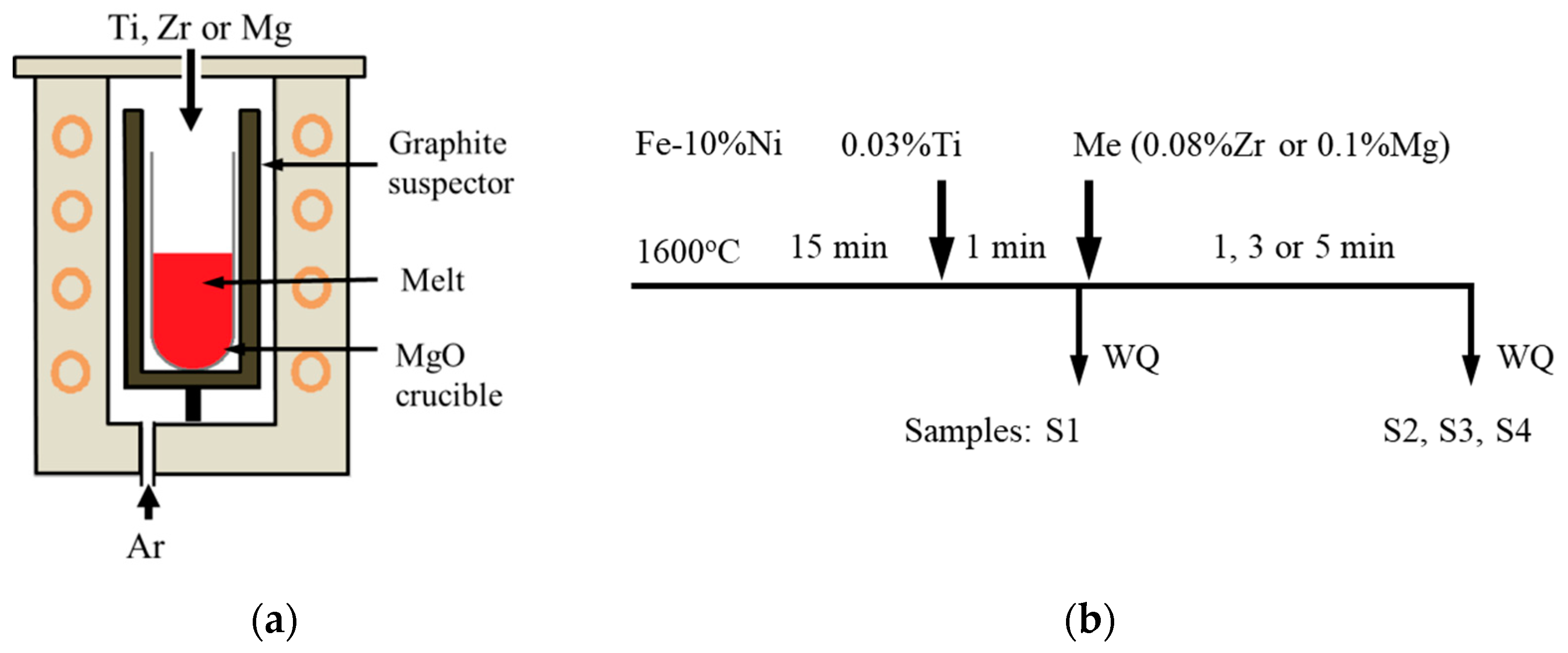
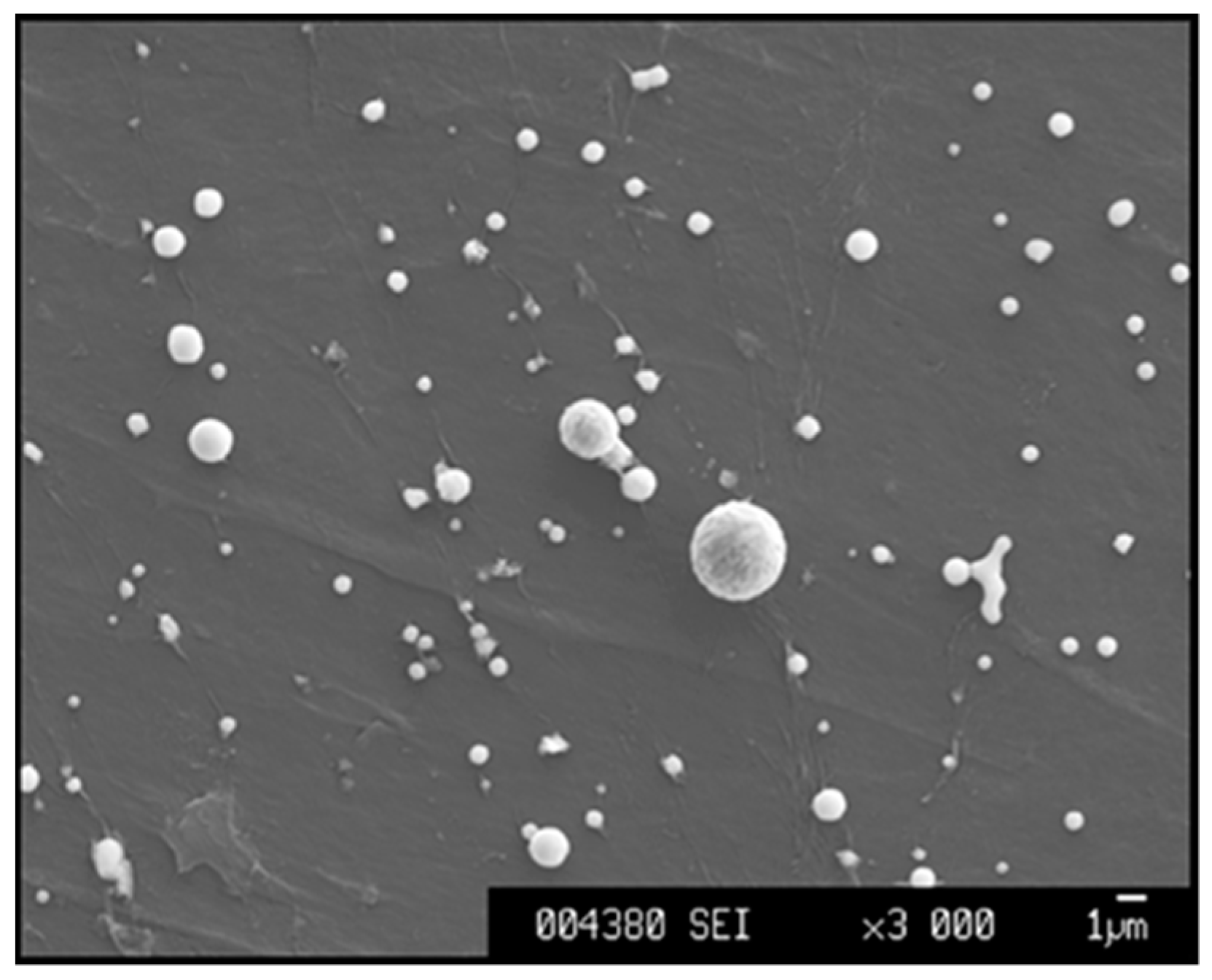

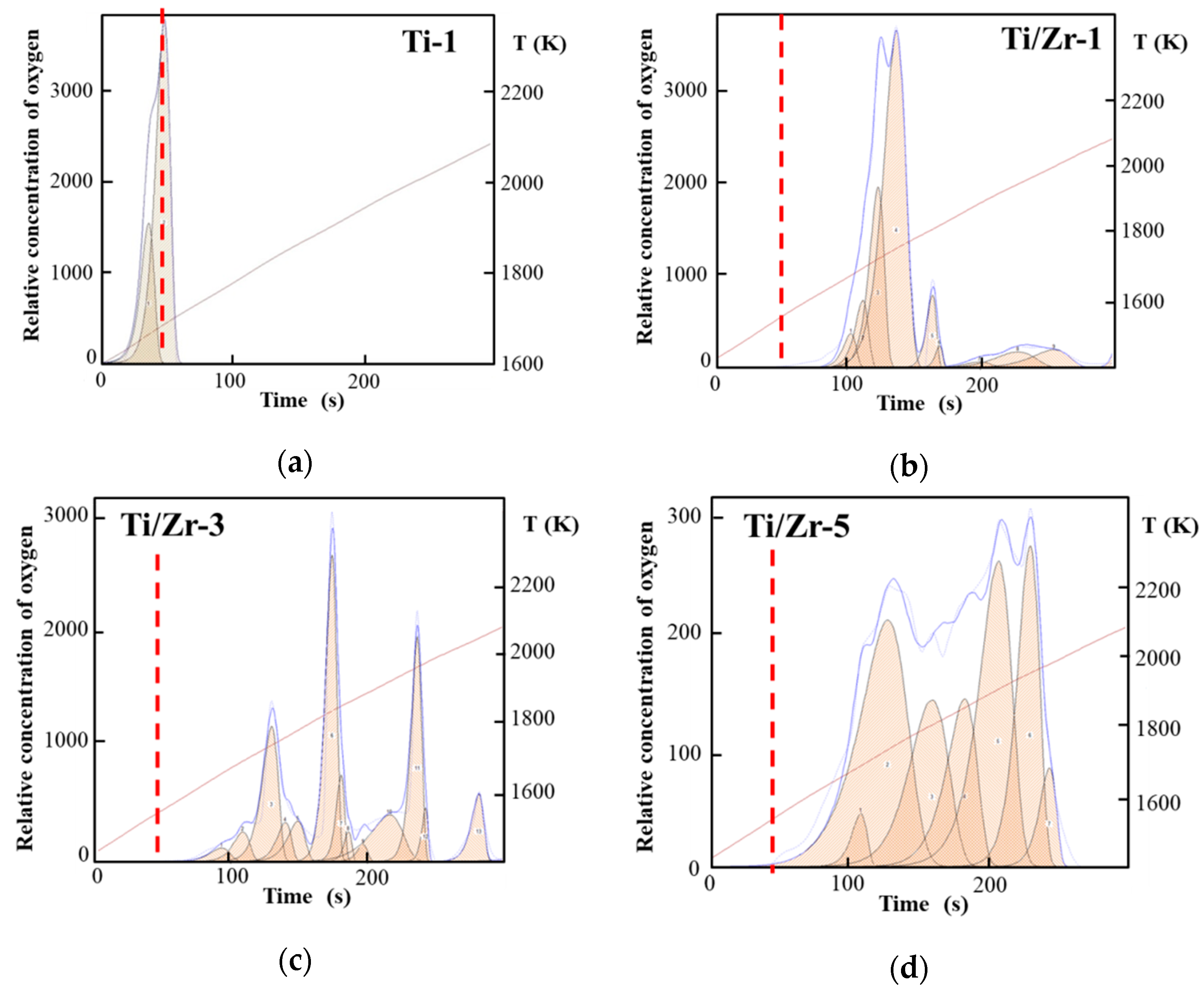
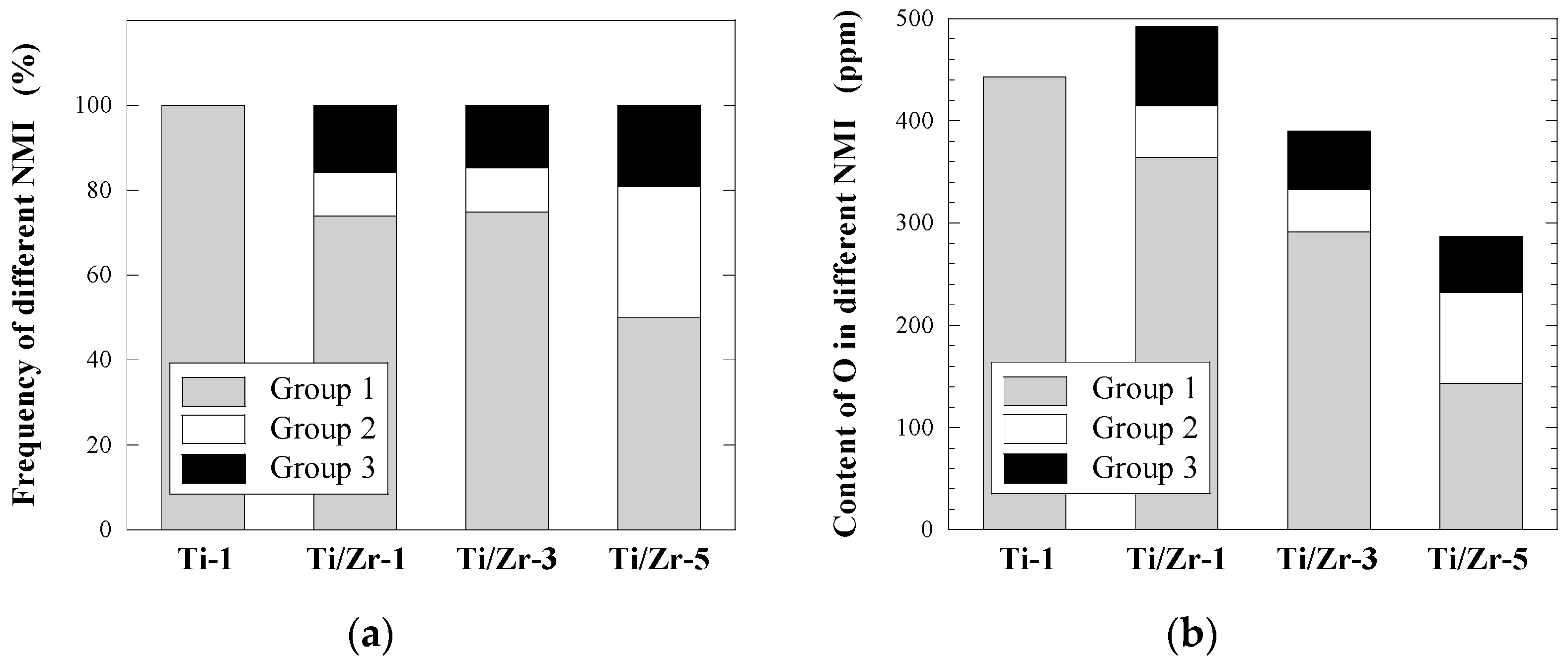
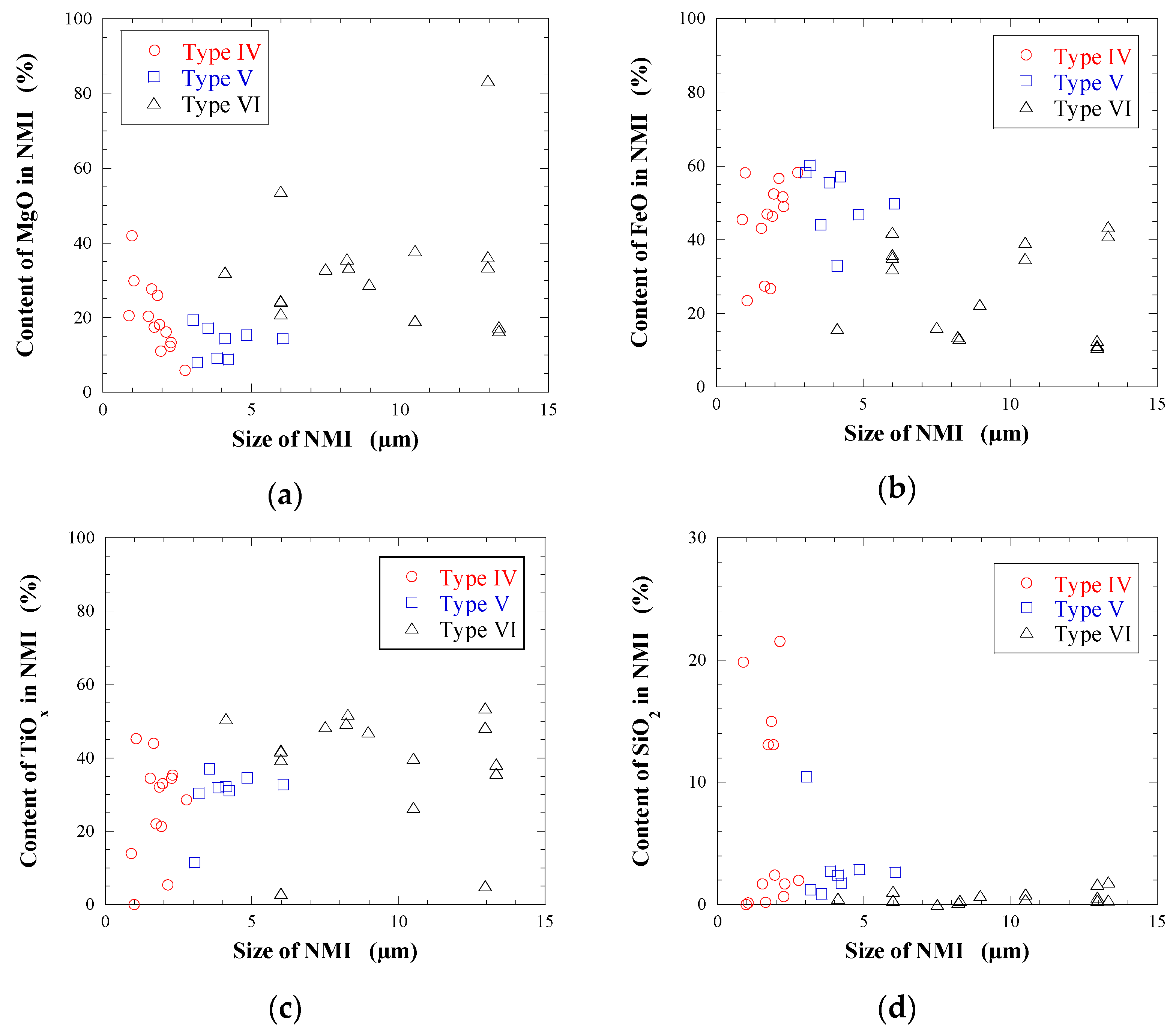
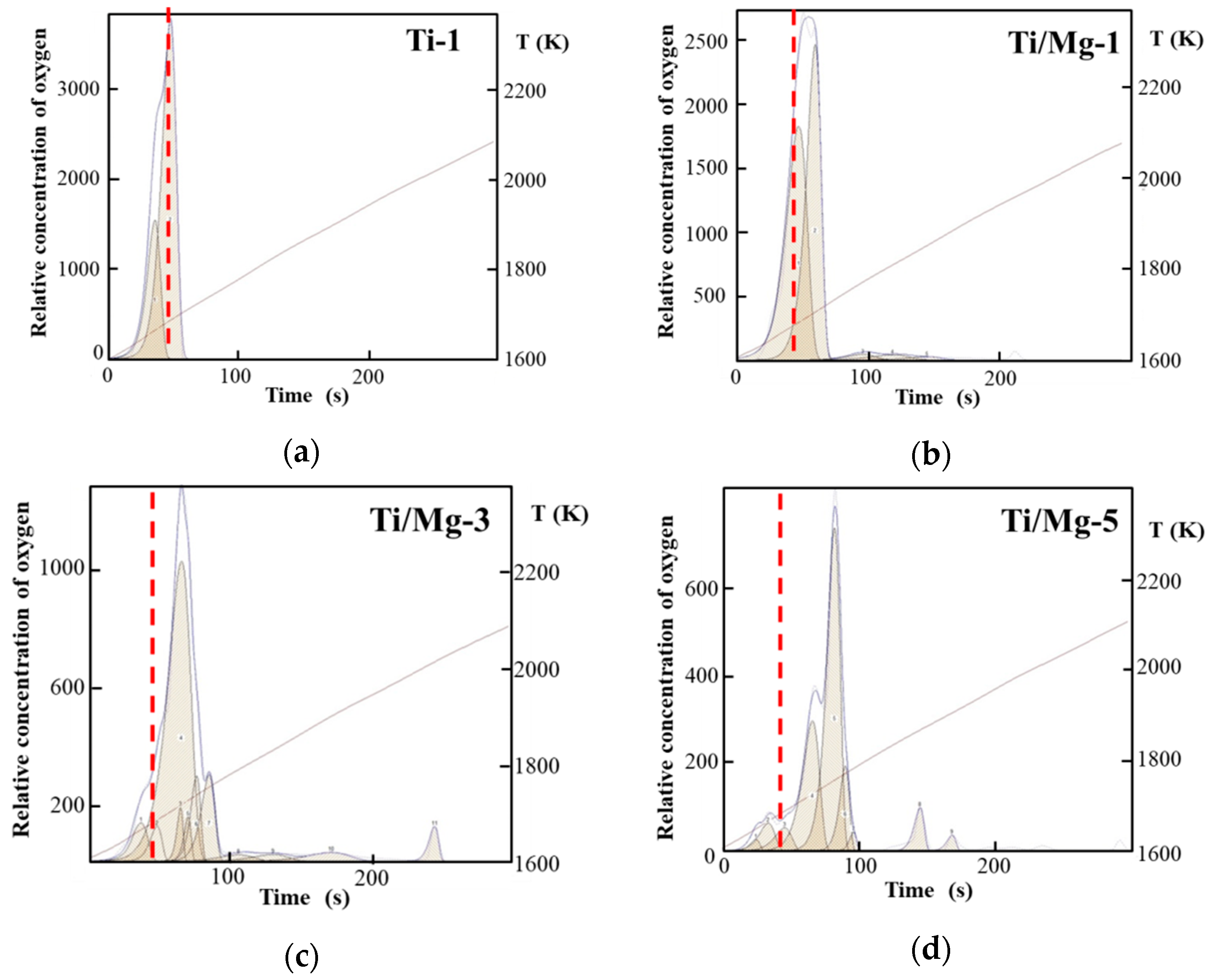
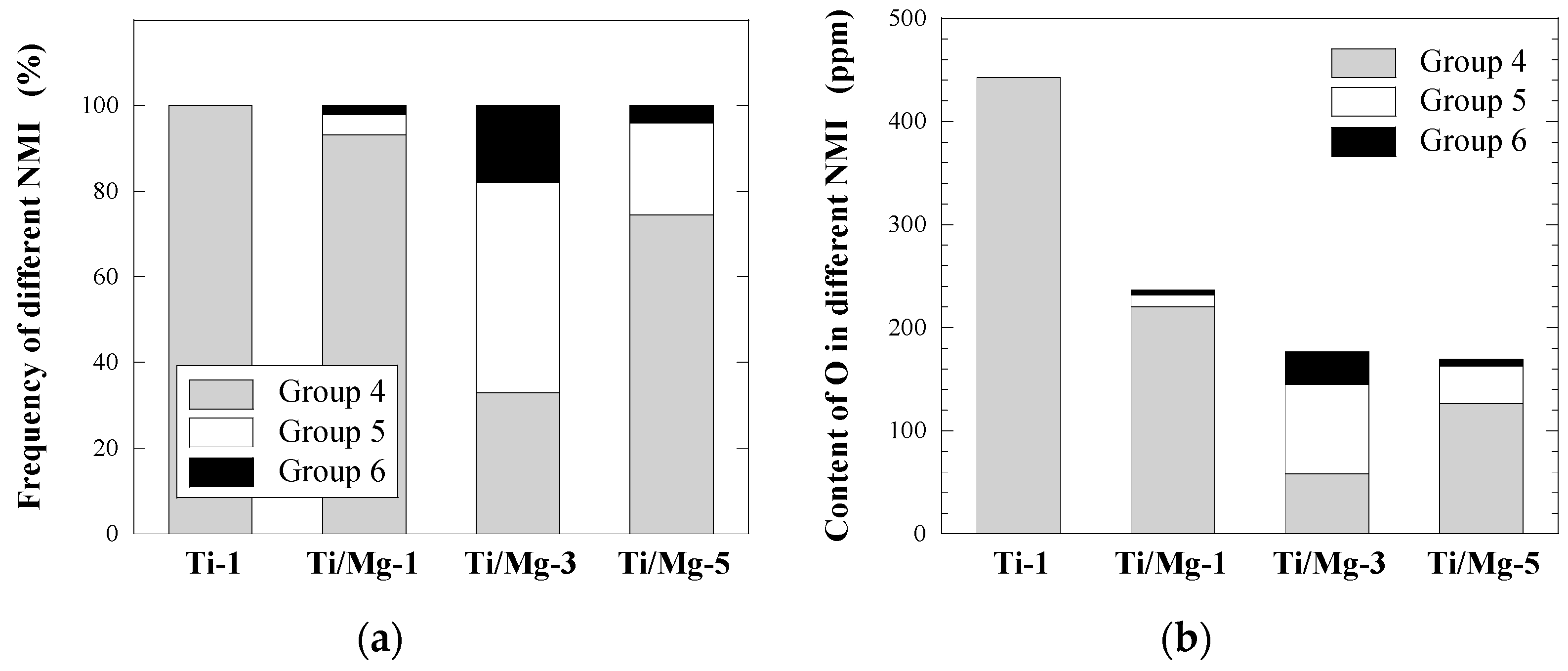
| Steels and Alloys | Impurity Content, (ppm) | Type and Critical Size of NMI | Ref. |
|---|---|---|---|
| Interstation free steels | H < 2; N < 15; C < 10, O < 15 | Deformable, <100 µm | [10] |
| Cord steels | H < 1.5; N < 40; O < 30; S < 50 | Deformable oxides, <30 µm; Non-deformable, <10 µm | [11] |
| Pipeline steels | H < 1.5; O < 10; S < 8; P < 50 | Deformable, <100 µm; manganese sulfides | [12] |
| Rail steels | H < 2.0; O < 20 | Non-deformable, <20 µm | [13] |
| Bearing steels | H < 2; N < 20; O < 15 | Non-deformable, <15 µm; Nitrides, oxide clusters | [14] |
| High strength microalloyed steels | H < 1; N < 30; O < 12; S < 10 | Non-deformable, <20 µm; Nitrides, carbides | [15] |
| Pure Aluminum Alloys | H < 0.5; C < 5, N < 40; O < 10 | - | [16] |
| Stainless steels | H < 5; N < 10; O < 20; S < 30 | Non-deformable, <15 µm | [17] |
| Ti micro-alloyed steels | H < 30; C < 200, N < 80; O < 200 | - | [18] |
| Method | Subject of Analysis | Analysis Time | Analyzed Parameters. Advantages | Disadvantages and Limitations | Ref. |
|---|---|---|---|---|---|
| Microchemical | Precipitate | ~1 day | Chemical composition | Labor intensity, complexity and low accuracy | [20] |
| Electrochemical or electrolytic extraction | Steel sample 0.1–30 g | 3 h–3 days | Analysis of morphology, composition, size and number of NMIs. | Labor intensity, complexity | [21] |
| Metallographic | Thin section, 10 cm2 | ~0.5 h | Analysis of morphology, size and number of NMIs. Rapidity | Influence of the capabilities of the microscope, the quality of thin sections, labor intensity and subjectivity of the assessment | [22,23] |
| Automatic image analyzers | Thin section, 10–200 mm2 | ~2–3 h | Rapidity, representative data | Influence of the capabilities of the microscope, the quality of thin sections, and influence of settings and analyzer type | |
| Local petrographic | Thin section | ~0.5 h | Structure and phase composition | Little informative when analyzing NMI | [24] |
| X-ray microanalysis | Thin section | ~2–3 h | Analysis of composition and morphology of inclusions. Locality. | Influence of thin section quality, subjectivity of results | [25] |
| PDA/OES spectrometry | Thin section, 60 mm2 | ~2–3 min | Analysis of AI, Ca in inclusions. Short analysis time. | Low precision, semi-quantitative results | [26] |
| Gas analysis (C, O, H, N, S) | Steel sample 1–3 g | ~1–2 min | High accuracy, short analysis time. | Integral characteristics only | [27] |
| Type of NMI | SEM Image of NMI | Composition (Mass%) | Size Range (µm) | AR |
|---|---|---|---|---|
| Type I |  | 49–100% FeO, 0–39% ZrO2, 0–36% TiOx, 0–11% Al2O3 | 0.5–5.2 | 1–1.2 |
| Type II | 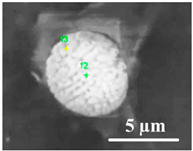 | 18–94% FeO, 0–78% ZrO2, 4–33% TiOx, 0–7% Al2O3 | 2.5–13.5 | 1–2.7 |
| Type III | 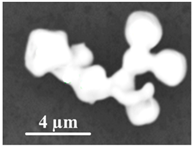 | 0–24% FeO, 64–100% ZrO2, 0–36% TiOx, 0–1% Al2O3 | 2.8–26.1 | 1.1–3.8 |
| Group | Tm (K) | Tm (°C) | Oxides |
|---|---|---|---|
| 1 | 1670–1800 | 1397–1527 | FeO, FeO-TiOx, FeO-TiOx-ZrO2 |
| 2 | 1800–1930 | 1527–1657 | TiOx, TiOx-ZrO2 |
| 3 | 1930–2150 | 1657–1877 | ZrO2-TiOx, ZrO2 |
| Type of NMI | Composition (Mass%) | Size Range (µm) | AR |
|---|---|---|---|
Type IV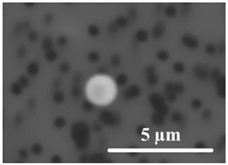 | 21–58% FeO, 6–42% MgO, 0–45% TiOx, 0–5% Al2O3, 0–21% SiO2 | 0.5–2.5 | 1–1.5 |
Type V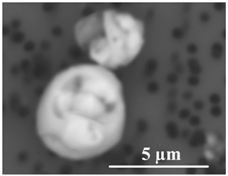 | 22–60% FeO, 8–56% MgO, 11–37% TiOx, 0–18% Al2O3, 1–13% SiO2 | 2.6–6.1 | 1–1.6 |
Type VI | 11–44% FeO, 16–83% MgO, 3–54% TiOx, 0–4% Al2O3, 0–2% SiO2 | 4.1–13.3 | 1.2–2.5 |
| Group | Tm (K) | Tm (°C) | Oxides |
|---|---|---|---|
| 4 | 1670–1770 | 1397–1497 | FeO, FeO-TiOx, Fe-TiOx-MgO |
| 5 | 1770–1900 | 1497–1627 | TiOx, TiOx-MgO |
| 6 | 1900–2150 | 1627–1877 | MgO-TiOx, MgO |
Publisher’s Note: MDPI stays neutral with regard to jurisdictional claims in published maps and institutional affiliations. |
© 2021 by the authors. Licensee MDPI, Basel, Switzerland. This article is an open access article distributed under the terms and conditions of the Creative Commons Attribution (CC BY) license (http://creativecommons.org/licenses/by/4.0/).
Share and Cite
Karasev, A.V.; Gorkusha, D.; Grigorovich, K.V.; Jönsson, P.G. Application of Some Modern Analytical Techniques for Characterization of Non-Metallic Inclusions in a Fe-10mass%Ni Alloy Deoxidized by Ti/Zr and Ti/Mg. Metals 2021, 11, 448. https://doi.org/10.3390/met11030448
Karasev AV, Gorkusha D, Grigorovich KV, Jönsson PG. Application of Some Modern Analytical Techniques for Characterization of Non-Metallic Inclusions in a Fe-10mass%Ni Alloy Deoxidized by Ti/Zr and Ti/Mg. Metals. 2021; 11(3):448. https://doi.org/10.3390/met11030448
Chicago/Turabian StyleKarasev, Andrey V., Dmitry Gorkusha, Konstantin V. Grigorovich, and Pär G. Jönsson. 2021. "Application of Some Modern Analytical Techniques for Characterization of Non-Metallic Inclusions in a Fe-10mass%Ni Alloy Deoxidized by Ti/Zr and Ti/Mg" Metals 11, no. 3: 448. https://doi.org/10.3390/met11030448
APA StyleKarasev, A. V., Gorkusha, D., Grigorovich, K. V., & Jönsson, P. G. (2021). Application of Some Modern Analytical Techniques for Characterization of Non-Metallic Inclusions in a Fe-10mass%Ni Alloy Deoxidized by Ti/Zr and Ti/Mg. Metals, 11(3), 448. https://doi.org/10.3390/met11030448






